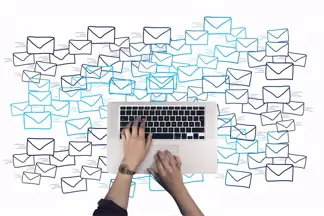Types of Recruiting Emails That Capture Top Talent's Attention
Attracting high-caliber talent is a formidable task, particularly in today's competitive job market. Cold recruiting, which entails sending unsolicited recruiting emails to potential candidates, can be especially challenging. Candidates are often already being contacted by other companies and bombarded by agencies and contracted recruiters. To stand out and attract the best candidates, it's crucial to write effective recruiting emails that engage and nurture talent.
This article from Aniday explains the different types of recruitment emails that can help you get the attention of top talent. Learn the importance of automating your recruitment email outreach, the types of emails you should include in your cold outreach, and email marketing best practices to use to increase your email effectiveness.
Automating Your Recruiting Email Outreach

Automating tasks like cold recruiting outreach can save time and make it easier for hiring teams to reach the talent they want to recruit. By using solutions like LeverTRM, you can automate various recruiting workflows, including outreach, scheduling, and nurturing. This automation allows recruiters to focus on more strategic activities and avoid wasting time on menial tasks like email setup and sends.
Recent data shows that automation and AI are most helpful for engaging and nurturing candidates. By automating your recruiting email outreach, you can ensure consistent and timely communication with potential candidates, increasing your chances of converting them into qualified applicants.
Types of Recruiting Emails

To craft effective recruiting emails, it's important to understand the different types of emails you should send and the goals associated with each one. Here are the key types of recruiting emails to include in your cold outreach:
1. Introduction Email
The introduction email is the first email you'll send when reaching out to a candidate. It sets the stage for your interactions with the candidate and should include all the relevant details that would matter to someone who has never interacted with your company before.
Think of your introduction email as an elevator pitch. It should be concise, easy to read, and offer only the most relevant information. Avoid using jargon or ambiguous language. Provide clear direction to the candidate on what they should do once they've read your email and what the next steps are.
Here's an example of an introduction email template that you can personalize based on the candidate and role:
Hi [Candidate's Name],
I hope this email finds you well. My name is [Your Name], and I'm a recruiter at [Your Company]. I came across your profile on [Platform/Source] and was impressed with your experience in [Relevant Skill/Industry].
We currently have an exciting opportunity for a [Job Title] at our company. The role involves [Brief Description of Role]. Based on your skills and background, I believe you would be an excellent fit for this position. I am interested in discussing this opportunity further with you. Could we schedule a brief call or video chat sometime this week? Please let me know your availability.
Looking forward to connecting!
Best regards, [Your Name] [Your Contact Information]
2. Follow-up Email
If you haven't heard back from a candidate after sending the introduction email, it's important to send a follow-up email. This email should provide additional information or context about the role and why the candidate should respond.
To make your follow-up email more effective, personalize your messaging and avoid generic content. Show genuine interest in the candidate and address any concerns or questions they may have. This will demonstrate that you value their time and are committed to building a meaningful connection.
3. Nurture Email
A nurture email is different from a follow-up email. It is designed to re-engage candidates who may not be ready to make a move at the moment or are busy with their current role. Nurture emails should provide updates on new roles, company news, and insights into your company's culture and diversity initiatives.
By keeping candidates informed and engaged, you increase the likelihood of them considering your company for future opportunities. Nurture emails can help build a relationship with candidates and keep your company top of mind when they are ready to explore new roles.
4. Referral Email
Referral emails are useful when you proactively source new talent from existing employees, recruiters' networks, or third-party connections. These emails are personalized and typically involve reaching out to a candidate someone in your network told you about.
When sending a referral email, make it clear that you value the recommendation and explain why you think the candidate would be a good fit for the role. Personalize the email and highlight any specific skills or experiences that make the candidate stand out.
5. Last Touch-point Email
You may miss opportunities to connect with candidates due to factors such as timing and decisions to pursue other opportunities. In these cases, we recommend letting the candidate know that you do not want to seek further communication with them.
In your last touch-point email, thank the candidate for their time and express your understanding of their decision. You can also use this opportunity to request a referral if they know someone who might be interested in the role. Additionally, offer to include them in your company newsletter or other communications to stay connected for potential future opportunities.
Email Marketing Best Practices for Recruiting Outreach

To enhance the effectiveness of your recruitment emails and boost your likelihood of attracting top talent, it's beneficial to integrate email marketing best practices. Here are some recommendations to help you distinguish yourself from competitors.
1. Research candidates before reaching out: Understand the candidates you're targeting and build your own pipeline of top talent. This allows for more meaningful communication and personalized outreach.
2. Write compelling subject lines: Subject lines are essential for capturing recipients' attention. Keep them concise, clear, and personalized. Avoid generic subject lines that may be easily overlooked or mistaken for spam.
3. Include a clear call to action (CTA): Your email should have a clear purpose and a specific action you want the candidate to take. Make your CTA concise, easy to follow, and relevant to the candidate's interests.
4. Personalize your emails: Tailor your emails to the candidate's background and interests. Show that you've done your research and genuinely believe they are a good fit for the role.
5. Leverage your email signature: Use your email signature to showcase your company's brand and recruitment marketing messages. Include links to relevant content and social media profiles.
6. Use social media to connect: Connect with candidates on social media platforms to build relationships and stay engaged with their professional updates. This can help you nurture the relationship and provide valuable insights into their interests and goals.
7. Have a follow-up strategy: Plan follow-up actions for candidates who have shown interest or engaged with your emails. This can include scheduling additional conversations, providing more information, or addressing any questions or concerns they may have.
8. Measure the results: Track the success of your recruiting email outreach by monitoring open rates, click-through rates, and responses. Analyze the data to identify areas for improvement and optimize your future outreach efforts.
By incorporating these email marketing best practices into your recruiting outreach, you can create more engaging and effective emails that capture the attention of top talent.
Conclusion
Crafting effective recruiting emails is crucial for attracting and converting top talent. By automating your recruiting email outreach, understanding the types of emails to include in your cold outreach, and applying email marketing best practices, you can increase your chances of engaging and nurturing qualified candidates. Remember to personalize your emails, provide relevant information, and make your CTAs clear and concise. By following these strategies from Aniday, you'll be well-equipped to capture the attention of top talent and drive successful recruitment outcomes.
Aniday's HR Services
Headhunting Service
Find and recruit quality candidates in just 1 week! Supported by 40,000 experienced headhunters in IT, Finance, Marketing… capable of recruiting in any region.
Headhunting Service ➔Employer of Record (EOR) Service
On behalf of your business, we recruit employees and handle payroll without the need to establish a company in markets such as Vietnam, Singapore, Malaysia, India, Indonesia…
Employer of Record (EOR) Service ➔